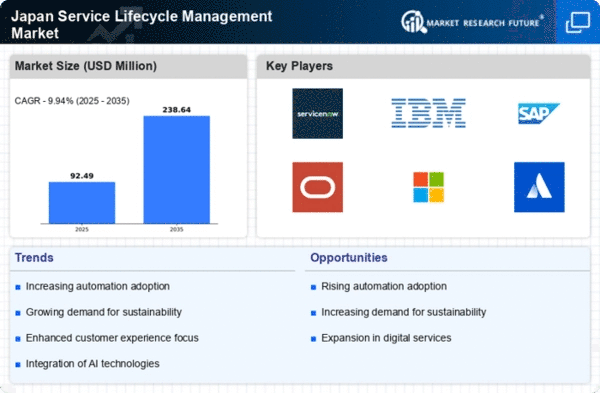The service lifecycle-management market in Japan is characterized by a dynamic competitive landscape, driven by rapid technological advancements and increasing demand for efficient service delivery. Key players such as ServiceNow (US), IBM (US), and SAP (DE) are at the forefront, each adopting distinct strategies to enhance their market presence. ServiceNow (US) focuses on innovation through its cloud-based solutions, aiming to streamline service management processes. IBM (US), on the other hand, emphasizes digital transformation and AI integration, positioning itself as a leader in providing intelligent service management solutions. SAP (DE) leverages its extensive enterprise resource planning (ERP) capabilities to offer integrated service lifecycle solutions, thereby enhancing operational efficiency for its clients. Collectively, these strategies contribute to a competitive environment that is increasingly centered around technological innovation and customer-centric service delivery.
In terms of business tactics, companies are increasingly localizing their operations to better cater to the unique demands of the Japanese market. This localization often involves optimizing supply chains and enhancing customer support services. The market structure appears moderately fragmented, with several key players exerting significant influence. However, the presence of large multinational corporations suggests a concentrated competitive environment where scale and technological prowess are critical for success.
In October 2025, ServiceNow (US) announced a strategic partnership with a leading Japanese telecommunications provider to enhance its service management capabilities. This collaboration is expected to facilitate the integration of advanced AI technologies into service delivery, thereby improving customer experiences and operational efficiencies. Such partnerships are indicative of a broader trend where companies seek to leverage local expertise to enhance their service offerings.
In September 2025, IBM (US) launched a new AI-driven service management platform tailored specifically for the Japanese market. This platform aims to automate routine service tasks, thereby allowing organizations to focus on strategic initiatives. The introduction of this platform underscores IBM's commitment to innovation and its understanding of the local market's needs, potentially positioning it as a preferred choice among Japanese enterprises.
In August 2025, SAP (DE) expanded its service lifecycle management solutions by integrating sustainability metrics into its offerings. This move aligns with the growing emphasis on environmental responsibility among Japanese companies. By providing tools that help organizations track and manage their sustainability goals, SAP is likely to enhance its appeal in a market increasingly focused on sustainable practices.
As of November 2025, the competitive trends in the service lifecycle-management market are heavily influenced by digitalization, sustainability, and AI integration. Strategic alliances are becoming more prevalent, as companies recognize the value of collaboration in enhancing service delivery and operational efficiency. Looking ahead, competitive differentiation is expected to evolve, with a shift from traditional price-based competition towards innovation, technological advancement, and supply chain reliability. This transition suggests that companies that prioritize these aspects will likely gain a competitive edge in the increasingly complex market landscape.

















Leave a Comment